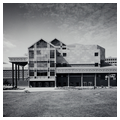The $71 million Alaska Center for the Performing Arts is an exercise in Postmodern design that has garnered its share of praise and criticism. The Center for the Performing Arts includes a lively, many-textured exterior and three theaters inside, and it stands as both the symbolic and active center of culture for the city. Designed by Hardy Holzman Pfeiffer Associates of New York, in association with Livingston Slone, Inc., of Anchorage, this beneficiary of the capital improvement fund was begun in 1985; the first theater opened in 1988.
The center includes three theaters and an outdoor park on a confined site. The massing is arranged with the extremely tall flies of each theater set in the center of the building, with steep hip roofs falling away. The pitch of the metal-clad roofs is interrupted by snow fence constructions, which were part of the original plans, not an afterthought, as is widely believed. Consuming more than a city block, city planners had to reorder traffic patterns to accommodate its size. A main north-south thoroughfare, F Street, was cut off and its right-of-way incorporated into the building site. This created limited access to the building, as there is no drop-off for automobiles, and the entrances are on the wrong sides of one-way streets. There is no parking within the building, and an adjacent parking garage is slated for demolition. Therefore, street and surface parking are the closest options.
The Anchorage Town Square Park is directly outside of the performing arts center. It is an open space that has drawn criticism for being a hangout and location for drug activity and petty crime. More recently, many of its small features such some raised hills, a fountain, and concrete planters have been razed to increase sightlines and provide for greater security and surveillance of the park. In the summer, Town Square Park hosts food festivals and outdoor performances; in winter, Town Square Park and the performing arts center are lit up and are a hub of festivities around the holidays.
Consistent with Postmodern design, the architects used a pastiche of textures and styles, along with several gabled entrances, porticos, and arcades in the building and its connecting park. The first floor of the center is clad in small, textured brick, the second with a larger concrete block, and the stucco upper stories are scored in an even larger pattern. The whole is toned in shades of brown and rose that lighten from bottom to top. The tall and narrow gabled pavilions, which denote the lobby areas on three sides, also provide strong vertical elements. These are countered by the blue horizontal stringcourse and computer-programmed neon fascia that encircle the building and add a stabilizing horizontal thrust.
On the interior, the lobby areas are well lit by multistoried windows and decorated with work from Alaskan artists, including stylized masks on the walls, marble mazes in the windows, and the carpet on the floor, all funded by the city's One Percent for Art program. Each theater is separated from the lobbies and exterior walls by a circulation ring, insulating it from outside noise. Theater goers may mingle in the commons during intermission or before the show and enjoy a wine or refreshment.
The three theaters include the Evangeline Atwood Concert Hall, the Discovery Theatre, and the Syndey Laurence Theatre. Each has a somewhat separate function and hosts different kinds of events. The largest theater is the Atwood Concert Hall, seating 2,146. The acoustics of this U-shaped theater with two balconies are particularly fine and designed for symphonies, high profile theatric productions, and national touring acts. The baffling on the ceiling, an acoustic shell of gypsum wallboard on metal studs, is known as the aurora borealis; it also conceals the lights. The Discovery Theatre—so named because the oil companies donated funds for it—seats 777 and occupies the round element at the southwest corner of the building. The Discovery Theatre hosts musical performance and theatric productions that are more limited in scope than those at the Atwood Concert Hall. The 372-seat Sydney Laurence Theatre is constructed within the walls of the theater of the same name that previously stood on the site. Its more intimate setting is used for chamber music, theater, and local performances. Its asymmetry—so that the audience is not evenly balanced in front of the stage—indicates a more informal space.
The facility has become a lightning rod for public opinion about Postmodern architecture in Anchorage. Although resented more for its cost than for its design, the building's critics also point out the inconvenience caused by limited access. Yet the building has made many people who were previously apathetic to architectural design take note, and it provides Anchorage with performing arts facilities that would be the envy of many cities twice its size in the Lower 48. Yet the facility was also brought major controversy even prior to its completion. The Anchorage Assembly voted unanimously to name the center after Martin Luther King, Jr. This was a moment in which the legendary civil rights icon received significant national recognition, namely in the passage of a federal holiday in his name. However, backlash against naming the center after King emerged within Anchorage’s white conservative community, who felt his name did not merit any attachment to a public building. Several activists appealed the assembly’s decision and garnered signatures necessary to put the question before voters. In October 1987, a majority of Anchorage residents overruled the assembly and voted to remove King’s name from the facility. The controversy laid bare questions of race and the legacy of civil rights in Anchorage. Since that time, the building has been known as the Alaska Center for the Performing Arts.
References
Mauer, Richard. "Center for the Performing Arts Is Off to a Sour Start." Anchorage Journal, December 15, 1988.






